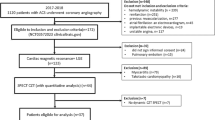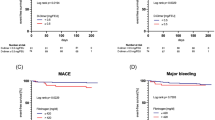Abstract
Objective: Since the role of fibrinolytic activity is unclear in coronary artery ectasia, we investigated the entire fibrinolytic activity by a new test, global fibrinolytic capacity (GFC) in the ectasia patients. Methods and results: Thirty-four ectasia patients (18 male, mean age: 58 ± 8 years) presenting with acute coronary syndrome and 25 controls (14 male, mean age: 56 ± 9 years) with normal coronary artery were evaluated. GFC, D-dimer and other hemostatic factors were assessed. Clinical characteristics were comparable in both groups. Serum GFC (4.6 ± 2.1 vs. 3.1 ± 2.1 μg/ml, p = 0.03) and D-dimer levels (0.69 ± 0.42 vs. 0.41 ± 0.38 ng/ml, p = 0.02, respectively) were significantly higher in ectasia patients than in controls. They were also higher in subgroup of patients with myocardial infarction (four patients) compared with other ectasia patients and controls (p = 0.04, 0.01, respectively). Other hemostatic factors were not different in both groups. GFC was correlated with D-dimer (r = 0.76, p = 0.01). Conclusion: Our results suggest that fibrinolytic system activation may develop in ectasia patients with acute coronary syndrome. It can be induced by thrombus formation in ectatic segment of coronary artery.
Similar content being viewed by others
References
Hartnell GG, Parnel BM, Pridie RB. Coronary artery ectasia, its prevalence and clinical significance in 4993 patients. Br Heart J 1985; 54: 392–395.
Seljeflot I, Eritsland J, Andersen P, Arnesen H. Global fibrinolytic capacity assessed by the serum D-dimer test. Correlation between basal and stimulated values. Thromb Res 1994; 75: 157–162.
Seljeflot I, Arnesen H, Eritsland J, Smith P. D-dimer test after standardized coagulation. Fibrinolysis 1993; 7: 303–307.
Prisco D, Paniccia R, Bandinelli B, et al. Euglobulin lysis time in fresh and stored samples. Am J Clin Pathol 1994; 102: 794–796.
Amiral J, Malmejac A, Gin H, et al. Evaluation of the fi-brinolytic potential on plasma: physiological and pathological variations and association with cardiovascular disease risk factors. Fibrin Proteol 1999; 13: 1–10.
Prisco D, Paniccia R, Bandinelli B, et al. Effect of temperature and incubation time on D-dimer serum levels in healthy subjects. Thromb Res 2000; 97: 513–517.
Folsom AR, Aleksic N, Park E, Salomaa V, Juneja, Wu KK. Prospective study of fibrinolytic factors and incident coronary heart disease. The Atherosclerosis Risk in Communities (ARIC) Study. Arterioscler Thromb Vasc Biol 2001; 2: 611–617.
Nikfardjam M, Graf S, Beckmann R, et al. Fibrinolytic response to venous occlusion compared to physical stress test in young patients with coronary artery disease. Thromb Hemost 1999; 82 (Suppl 1): 80–84.
Sharifi M, Murdock DK, Engelmeier RS, Logenmann TN, Hoffmann MT, Olson K. Simultaneous presence of a large coronary aneurysm and ectasia in young patient with myocardial infarction – a case report. Angiology 1997; 48: 1001–1005.
Dogan A, Ozaydin M, Gedikli O, Altinbas A, Ergene O. Effect of trimetazidine on exercise performance in patients with coronary artery ectasia. Jpn Heart J 2003, in press.
Folsom AR, Wu KK, Rosamond WD, Sharretf R, Chambless L. Prospective study of hemostatic factors and incidence of coronary heart disease. ARIC study. Circulation 1997; 96: 1102–1108.
Meade TW, Ruddock V, Stirling V, Chakrabarti R, Miller GJ. Fibrinolytic activity, clotting factors and long-term incidence of ischemic heart disease in the Northwick Park Heart Study. Lancet 1993; 342: 1076–1079.
Olofsson BO, Dahlen G, Nilson TK. Evidence for increased levels of plasminogen inhibitor and tissue plasminogen activator in plasma of patients with angiographically verified coronary artery disease. Eur Heart J 1989; 10: 77–82.
Ridker PM, Vaughan DE, Stampfer MJ, Manson JE, Hennekens CH. Endogenous tissue-type plasminogen activator and risk of myocardial infarction. Lancet 1993; 341: 1165–1168.
Cortellaro M, Cofrencesco E, Boschetti C, et al. Increased fibrin turnover and high PAI-1 activity as predictors of ischemic events in atherosclerotic patients: a case control study. Arterioscler Thromb 1993; 13: 1412–1417.
Ridker PM, Hennekens CH, Cerskus A, Stampfer MJ. Plasma concentration of cross-linked fibrin degradation product (D-dimer) and the risk of future myocardial infarction among apparently healthy men. Circulation 1994; 90: 2236–2240.
Lowe GDO, Yarnell JWG, Sweetnam PM, Rumley A, Thomas HF, Elwood PC. Fibrin D-dimer, tissue plasminogen activator, plasminogen activator inhibitor and the risk of major ischemic heart disease in the Caerphilly Study. Thromb Hemost 1998; 79: 129–133.
Fowkes FGR, Lowe GDO, Housely E, et al. Cross-linked fibrin degradation products, progression of peripheral arterial disease and risk of coronary heart disease. Lancet 1993; 342: 84–86.
Cushman M, Lemaitre RN, Kuller LN, et al. Fibrinolytic activation markers predict myocardial infarction in the elderly. The Cardiovascular Heart Study. Arterioscler Thromb Vasc Biol 1999; 19: 493–498.
Lowe GDO, Rumley A. Use of fibrinogen and D-dimer in prediction of arterial thrombotic events. Thromb Hemost 1999; 82: 667–672.
Juhan-Vague I, Pyke SDM, Alessi MI, On behalf of the ECAT Study Group. Fibrinolytic factors and the risk of myocardial infarction or sudden death in patients with angina pectoris. Circulation 1996; 94: 2057–2063.
Moss AJ, Goldstein RE, Marder VJ, et al. Thrombogenic factors and recurrent coronary events. Circulation 1999; 99: 2517–2522.
Danesh J, Whincup P, Walker M, et al. Fibrin D-Dimer and coronary heart disease. A prospective study and metaanalysis. Circulation 2001; 103: 2323–2327.
Granger CB, Becker R, Tracy RP, et al. Thrombin generation, inhibition and clinical outcomes in patients with acute myocardial infarction treated with thrombolytic therapy and heparin: results from the GUSTO-1 trial: GUSTO-I Hemostasis Substudy Group. J Am Coll Cardiol 1998; 31: 497–505.
Oldgren J, Linder A, Grip L, Siegbahn A, Wallentin L. Coagulation activity and clinical outcome in unstable coronary artery disease. Arterioscler Thromb Vasc Biol 2001; 21: 1059–1064.
Author information
Authors and Affiliations
Rights and permissions
About this article
Cite this article
Dogan, A., Tunc, B., Ergene, O. et al. Evaluation of overall fibrinolytic activity in patients with coronary artery ectasia: Global fibrinolytic capacity. Int J Cardiovasc Imaging 19, 465–471 (2003). https://doi.org/10.1023/B:CAIM.0000004339.30038.8d
Issue Date:
DOI: https://doi.org/10.1023/B:CAIM.0000004339.30038.8d




